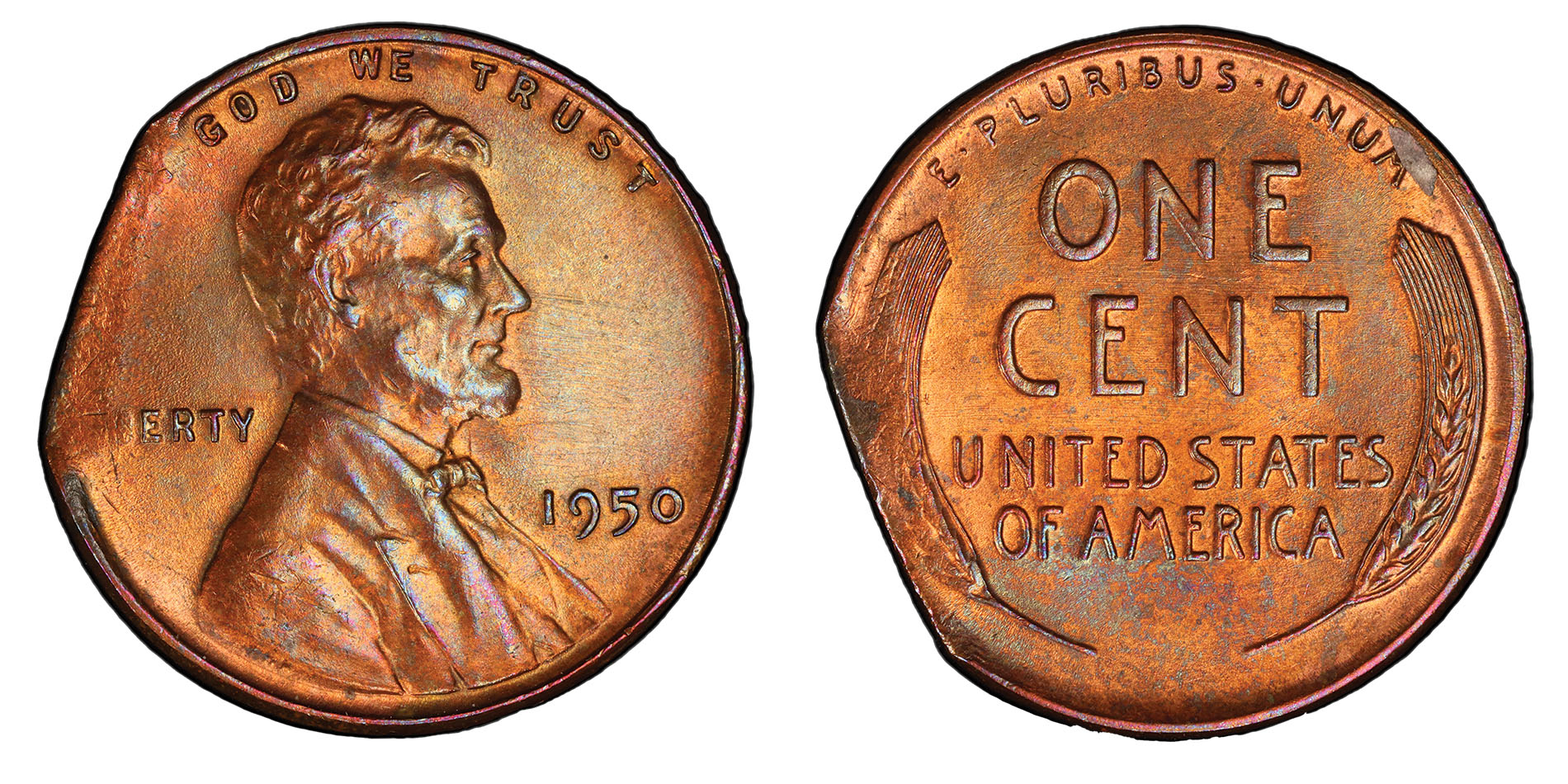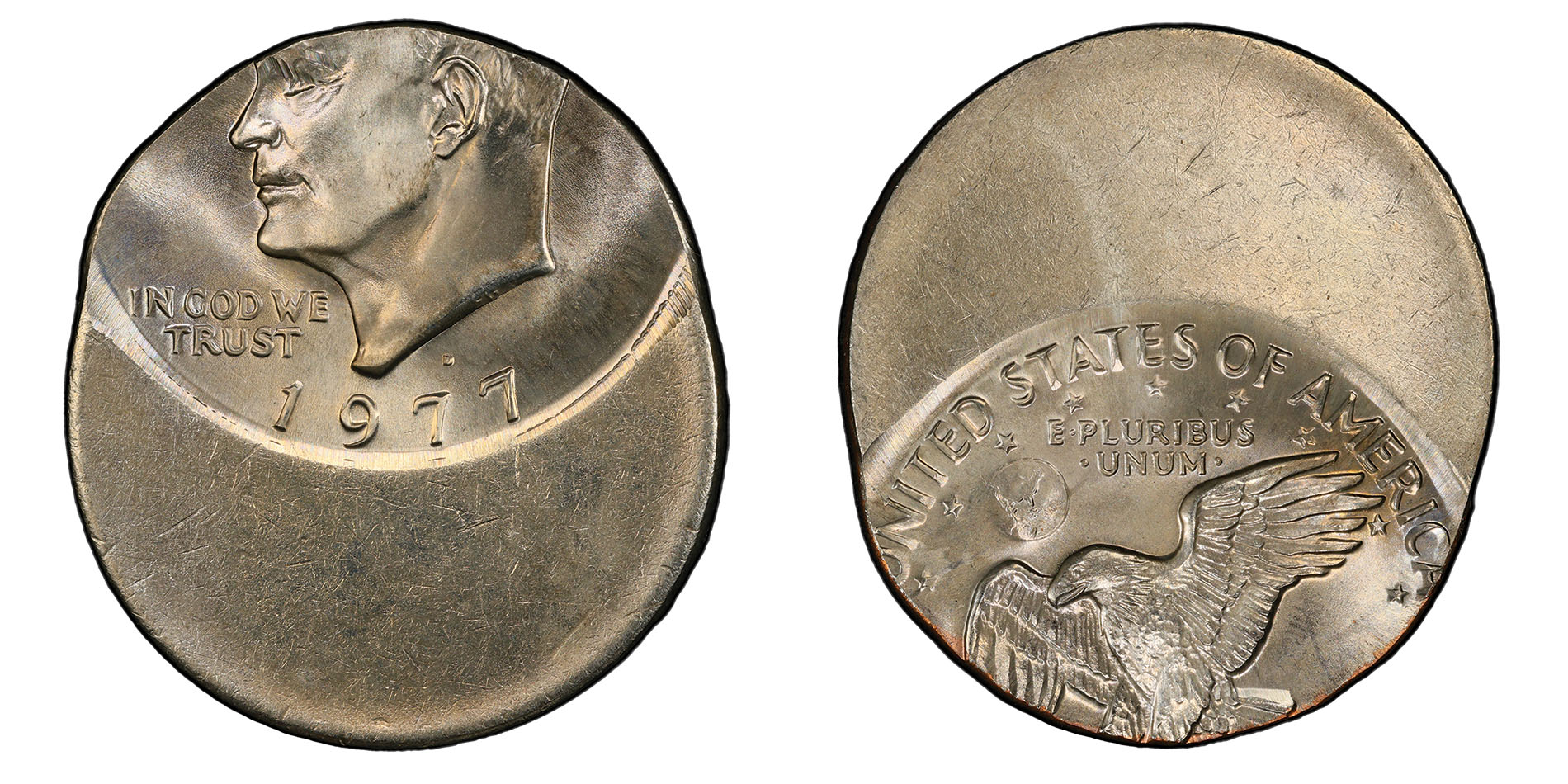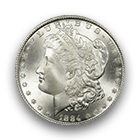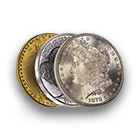A commonly found error coin type is the clipped planchet. This is one of the most well-known and popular coin errors, and it is found on coins ranging from the colonial era of the 1700s to 21st-century proof coins. There are many types of clipped planchets. Although they are different in how they appear, they are all created when either the planchet strip is not fed properly into a blanking press or there is a defect in the planchet strip itself, resulting in missing metal from a coin’s edge area. The missing metal makes the coin look like it has been “clipped” of some of its metal.
Blanks are the round disc of metal that will eventually be turned into a struck coin. These blanks are made when a roll or section of planchet strip is fed into a blanking press. The press has round, cylinder-shaped punches, which move up and down as the strip is fed into the press. With each downward stroke, blanks are “punched out” of the blanched strip. When all goes according to plan, the blanks will be perfectly round, and the shape of a normal blank for the respective denomination of coin.
However, if the planchet strip is fed into the press improperly, or if a press operator is not paying attention, a clip can occur. A curved clip can occur when the blanking dies can overlap previously punched-out holes in the strip, resulting in clips.
Sometimes, the punches can overlap either the “front,” “sides,” or “end” of the planchet strip, resulting in a “straight clip.” Straight clips have smooth, straight clips on them. Another clip type is the ragged clip, which comes from a blank being punched out so that it has a “ragged” edge in the clip area. This can occur when a blank is punched out from a defective area in the central area of the planchet strip, or if the blank is punched from one of the four sides of the strip that was not trimmed properly and has a “ragged” edge to it.
Although there are other kinds of clipped planchets, these three types – the curved, straight, and ragged clip – make up perhaps 99% of all clipped coins in existence. Some of the other clip types are actually just some version of these three clip types (and are effectively a “sub category” of these three types). Examples include crescent clips, which are just curved clips missing 60% or more of their planchet. Bowtie clips, which are coins with two or more large curved clips, are close together and opposite each other, and they make the clipped planchet visually resemble a “bowtie.”
Another clip type, which will have no metal “missing” on it, is the incomplete clip. This clip type occurs when the blanking die fails to fully punch out a blank, and then when the strip is moved forward to punch fresh blanks, it is not advanced far enough, and the blanking dies overlap the previously partially punched-out areas in the strip. This results in a blank with a curved line across its obverse and reverse (the line being where the first blanking die punch failed to punch out the blank). Incomplete clips are scarce, but they are not rare except within certain coin series (namely those from larger-denomination coins.) Cents and nickels are the most common coins to have incomplete clips. Some coins will even have two or three incomplete clips, or an incomplete clip in combination with another clip type.
A few other clip types exist, but most of them are rare. The outside corner clip, for example, is exceedingly rare and occurs when a blanking die overlaps one of the four corners of a roll of planchet strip, resulting in a “right angle”-shaped clip. The rarest type of clip is the inside-corner clip (also known as the “assay clip”), which occurs when a piece of planchet is “snipped” from the roll of planchet material. If a blank is punched out of that area, there will be a “snipped” area of planchet missing from it. Very few are known.
Clipped planchets can be collected by date and mintmark for a particular coin series, such as Lincoln Memorial Cents or Jefferson Nickels, or they can be collected as a type set, with a collector acquiring an example of every clip type.
Find examples which have clips that are large enough to be easily seen. In terms of grade, search for circulated or uncirculated coins that look nice – the same as you would with “non-mint error” coins. Clips that are in Mint State grades and boasting good eye-appeal with an easily visible clip are popular. A PCGS-graded example will be far easier to build into a set since the holder’s label will contain important information about the coin. And as an added bonus, a PCGS-graded example will be easier than a raw piece to sell down the line.
Most clipped planchets are worth more the larger and more visible they are, and also the higher the grade of the coin. A 75% clipped planchet Washington Quarter will be worth perhaps $200, versus a 5% clip on that same Washington Quarter garnering maybe $5. Lustrous, Mint State clipped coins will always be more desirable over low-grade circulated coins.
Pick a series, clip size, and grade that fits your budget, then have fun building your clip collection!








 Copper & Nickel
Copper & Nickel
 Silver Coins
Silver Coins
 Gold Coins
Gold Coins
 Commemoratives
Commemoratives
 Others
Others
 Bullion
Bullion
 World
World
 Coin Market
Coin Market
 Auctions
Auctions
 Coin Collecting
Coin Collecting
 PCGS News
PCGS News